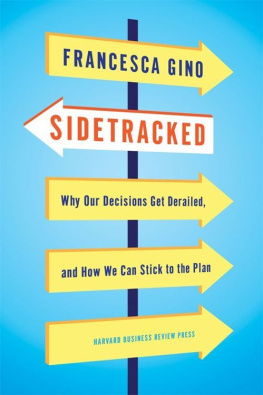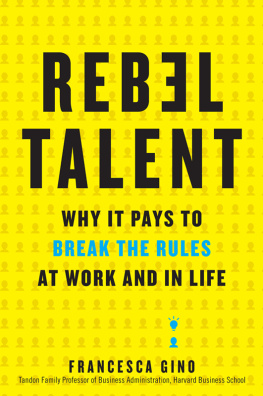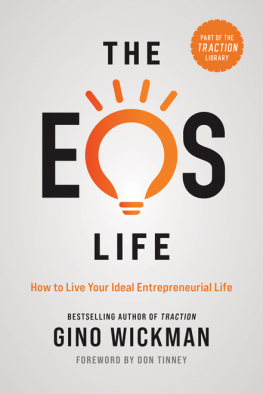
Copyright 2013 Francesca Gino
All rights reserved
Printed in the United States of America
10 9 8 7 6 5 4 3 2 1
No part of this publication may be reproduced, stored in or introduced into a retrieval system, or transmitted, in any form, or by any means (electronic, mechanical, photocopying, recording, or otherwise), without the prior permission of the publisher. Requests for permission should be directed to , or mailed to Permissions, Harvard Business School Publishing, 60 Harvard Way, Boston, Massachusetts 02163.
The Web addresses referenced in this book were live and correct at the time of the books publication but may be subject to change.
Library of Congress Cataloging-in-Publication Data
Gino, Francesca.
Sidetracked : why our decisions get derailed, and how we can stick to the= plan / Francesca Gino.
p. cm.
Includes bibliographical references and index.
ISBN 978-1-4221-4269-1 (alk. paper)
1. Decision making. I. Title.
BF448.G49 2013
153.83--dc23 2012034918
To Greg(orio)
Choosing to explore life hand in hand with
you has been by far my best decision
CONTENTS
Inaccurate Views of Ourselves |
Infectious Emotions |
An Overly Narrow Focus |
Lack of Perspective Taking |
Insidious Social Bonds |
Salient Social Comparisons |
Irrelevant Information |
Subtle Changes in Framing |
Ambience and Opportunity |

What Gets Us Off Track?
On a sunny day a few years ago, my husband, Greg, and I were wandering the streets of the Gold Souk in the old part of Dubai. Both my sister, who was living in Dubai with her family, and my travel guide had described the souka marketplace where you can buy products ranging from fresh food and spices to handicrafts and even goldas a must-see. Our plan for the afternoon was clear: Greg and I wanted to have an enjoyable day and buy something authentic that would help us remember the experience vividly once we were back home.
As we went from one tiny, packed store to the next, we noticed that amid the traditional shops lining the souks enchanted streets were other shops filled with fake designer handbags and knockoff designer clothing. Vendors ran after us, hawking Nike shoes, Versace T-shirts, Louis Vuitton bags, Prada wallets, and Ray-Ban sunglassesall of them at bargain prices, and all of them closely resembling the authentic products we were familiar with from home.
One vendor was particularly persistent. He convinced Greg to follow him to the back of his store, where the two spent almost an hour haggling over Rolex and Panerai watchesidentical copies of the real thing. Greg thought a fancy watch would make him look and feel good, and he doubted any of his friends or colleagues would be able to tell the difference.
After quite a bit of negotiating, Greg was ready to make a purchase: a copy of a Panerai Luminor Power Reserve mens watch, which typically sells for about $7,000 in the United States. Greg bought his perfect (in his mind) replica for just over $100.
He was thrilled, but his euphoria over getting such a good deal was short-lived. By the time we got back to our car, Greg said he couldnt help but feel a bit fake while wearing the watch. Ironically, this was exactly the opposite of our initial plan: having an authentic experience at the souk.
The decisions that we expect we will make based on our finely developed plans are often different from how we actually behave. We get sidetracked.
We set a new career path, we choose a diet to follow, we make plans to save for retirement, we set a new direction for the management team, or we promise to carefully research our next big purchase. And yet, like Greg, you may have found yourself following a course of action that took you completely off trackputting off your job search, sabotaging your diet, spending too much on trivial items, and so on. In the end, your outcome bore very little resemblance to your initial goal. Such results can be discouraging, demoralizing, and baffling.
We have a rose-colored view of who we are and what we do, and we aim to behave in ways that are consistent with our self-image as capable, competent, helpful, and honest individuals. We care about following through on our goals and wishes. And yet, even when we have spent time developing our plans and are fully committed to our best intentions, our decisions often veer off course in unexpected ways.
Greg set off to choose a souvenir that would enhance our authentic experience abroad, but left the souk feeling just the oppositeinauthentic and false. And Greg is not alone. I have observed experienced managers plan carefully for their negotiations but end up with very different deals than those they had planned because they were caught up in the heat of the moment. Ive seen friends make plans to improve their relationships but fail to follow them due to their inability to put themselves in their partners shoes. I have watched thoughtful managers planning new incentive schemes to motivate their employees, only to find the employees focused more on cheating the system than on working harder. And I have also noted similar inconsistencies in my own behavior. Why do our plans so often go astray, and how can we keep on track?
Over the last ten years, I embarked on a number of research projects that focused on answering just those questions. In Sidetracked, Ill share my findings.
Three different sets of forces influence our decisions in ways we commonly fail to anticipate: (1) forces from within ourselves, (2) forces from our relationships with others, and (3) forces from the outside world. Throughout Sidetracked, I will describe the results of various studies examining the power of these forces and how they operate. I will suggest that we can make more successful decisions by understanding these forces and that we can learn to account for them as we set goals or clarify plans of action. I will conclude each chapter by describing one principle for you to consider to avoid getting sidetracked in the future.
Forces from within are factors that reside in both our minds and our hearts, and exist because of the very nature of being human. We will explore the accuracy (or lack thereof) of our beliefs about our abilities and competence ().
Forces from our relationships are factors that characterize our relationships and interactions with others. We are social human beings, but our bonds with others often derail our plans. In the second part of the book, we will examine how this happens. I will discuss the difficulty of putting ourselves in others shoes ().
Finally, forces from the outside are factors that characterize the context in which we operate and make decisions. We will explore the effects of irrelevant information on our decisions ().
To a certain extent, all these forces were at play when Greg was deciding what to buy at the souk. Forces from within made him concentrate on how wearing a Panerai (albeit a fake) would make him feel, a prediction that turned out to be shortsighted and inaccurate. Forces from his relationships made him focus on the fact that he would look good relative to others, but at a much cheaper price; this focus may have clouded his understanding of the power of wearing counterfeits. And forces from the outsidethe heady atmosphere of the soukmay have had an impact as well.
Next page












